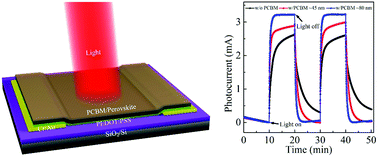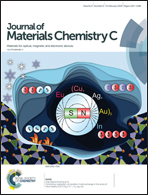Enhanced performance of perovskite/organic-semiconductor hybrid heterojunction photodetectors with the electron trapping effects
Abstract
Hybrid photodetectors with extremely high responsivities and cost-effective fabrication processes are highly desirable for the development of a number of innovative technologies in our modern society. However, their wide applications are usually hindered by the slow photoresponse. In this work, we demonstrated that both responsivity and response speed of photodetectors based on perovskite/organic-semiconductor hybrid heterojunctions can be simultaneously improved upon coating of a layer of [6,6]-phenyl-C61-butyric acid methyl ester (PCBM). The resultant devices exhibited responsivity as high as 2.46 × 109 A W−1, representing a ∼44% increment, along with ∼5 times faster response speed over control photodetectors without PCBM. The improvement is attributed primarily to the significant electron trapping effect of PCBM, which not only facilitates efficient separation of photocarriers and suppresses their recombination, but also provides an extra built-in electric field to accelerate the drift of photocarriers. In addition, PCBM can passivate the perovskite to eliminate trap states on its surface and grain boundaries, which is also beneficial for device performance improvement. The results and analysis presented here are useful for not only performance optimization of hybrid photodetectors, but also better understanding their device physics.



 Please wait while we load your content...
Please wait while we load your content...